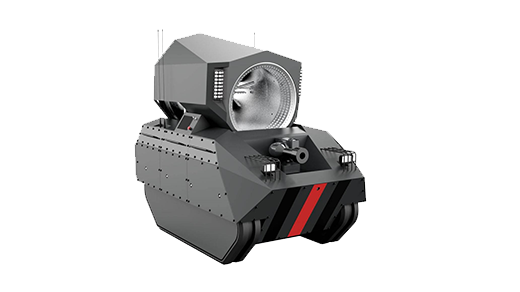

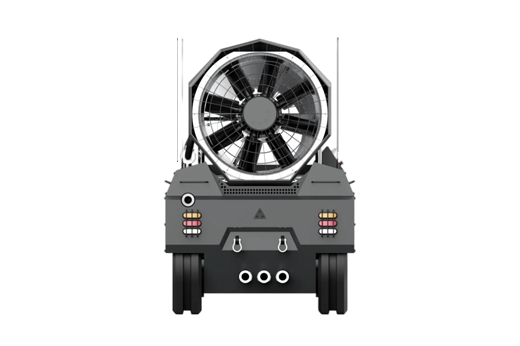
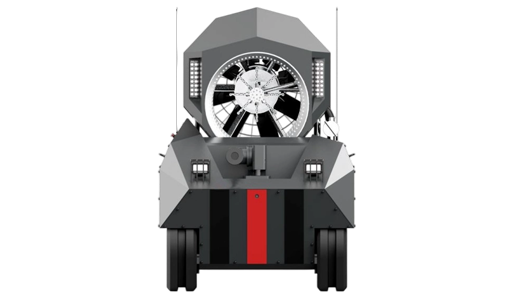
The Firefighting Smoke Extraction and Suppression Robot comprises a robotic platform, water cannon, fan, pan-tilt camera unit, and control box. It is designed for fire suppression, smoke extraction, and cooling across diverse scenarios, including urban areas, petrochemical plants, forests, tunnels, airports, ports, steel mills, power plants, coal mines, cigarette factories, paper mills, and other fire-prone environments. It significantly enhances rescue safety and reduces casualties.
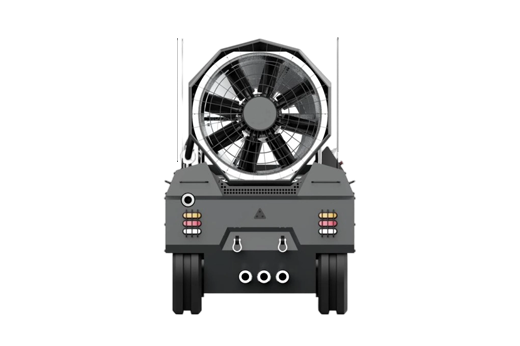
The air cannon adopts hydraulic lifting and pitching mechanism design, which can spray fine water mist for multi-dimensional fire smoke exhaust and eliminate toxic and harmful smoke particles; Intelligent linkage hidden independent water cannon design, not affected by water pressure, improves fire extinguishing efficiency.
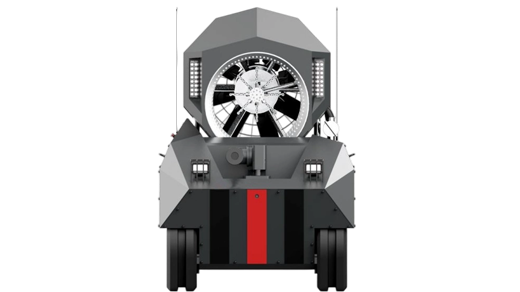
The power system design of diesel engine driven dual variable pump has strong power and endurance.
Long distance air supply, smoke exhaust, and fire extinguishing
The water mist flow rate of the robot smoke exhaust fan is 15L/m. Under a water pressure of 1.0MPa, the exhaust volume can reach 110000 m3/h; At the same time, the rated flow rate of the robot's water cannon is 80L/s, and under a water pressure of 1.0MPa, the range can reach over 80 meters. Firefighters can operate robots at a distance of 1000 meters to exhaust smoke, extinguish fires, and cool down, while ensuring a safe distance for firefighters when extinguishing fires in hazardous environments.
Automatic cooling system
The water mist valve system installed around the robot provides cooling protection for the robot itself during close range firefighting and reconnaissance.
Image Transmission
Real time on-site images can be captured and transmitted through the robot's infrared camera, including front and rear cameras, as well as fan and water cannon tracking cameras. The image transmission distance is 1000 meters.
lighting
The built-in lighting system of the robot can not only be used for its own tasks, but also provide auxiliary lighting for firefighters.
audible and visual alarm
The robot's built-in sound and light alarm system can issue sound and light warnings to the surrounding area during movement to ensure safety.
GPS positioning system (optional)
The GPS positioning system installed on the robot can provide real-time location information of the robot's position.
Hanging system (optional)
The hanging system on the robot is used to mount firefighters' oxygen cylinders, fire axes, demolition tools, water, food, and other equipment and rescue supplies into the disaster site.
Gas detector (optional)
Can be equipped with a gas detector for detecting air temperature and humidity values. It can detect the concentrations of 8 toxic and harmful gases, including CO, H2S, O2, SO2, VOC, Cl2, NH3, NO, etc. The remote control panel displays the gas content in real-time.
Infrared thermometer (optional)
An infrared thermometer can be installed for remote real-time detection of the temperature of high-temperature objects. The remote control panel displays the temperature in real-time.
Laser rangefinder (optional)
Laser rangefinder can be installed to measure a distance of 500 meters from the accident site. The remote control panel displays distance in real-time.
Electric reel (optional)
It can be used to rescue people trapped underground, in wells, under bridges, etc. when the dragging distance of the robot itself is limited, and can also be used for vertical lifting of materials and equipment, as well as necessary breaking and dismantling work.
Backup remote control (optional)
Backup remote control, which can be used as a backup in case of loss of the main remote control, to achieve redundant control of two or more remote controls.
Water hose self release device (optional)
After the robot completes the fire extinguishing task, it can automatically remove the water hose through its self detachment function and easily return to the base.
High pressure oil source system (optional)
Used to provide ultra-high pressure hydraulic source for other dismantling tools.
Hydraulic shovel (optional)
Used for bulldozing and clearing operations.
Power output system (optional)
Export electricity to provide power and charging for on-site lighting or electric tools.
Ultrasonic radar (optional)
Automatic parking within 1.5 meters when encountering obstacles, with a detection range of 0.3 to 3 meters. The automatic parking distance can be freely set, with a 60 ° conical detection.
PTZ camera (optional)
The 360 ° pan tilt camera can zoom and rotate.
Two way voice call (optional)
Can be equipped with a microphone and speaker for two-way communication via remote control.
Waterway cracking protection device (optional)
Prevent pressure water leakage in the water cannon system pipeline when the water hose cracks, ensuring that when one water hose cracks, it does not affect the normal use of the water cannon.
Rescue stretcher vehicle (optional)
It can transport rescue supplies to the disaster site together, and also take the injured away from the disaster site to save firefighters' energy and improve rescue efficiency.
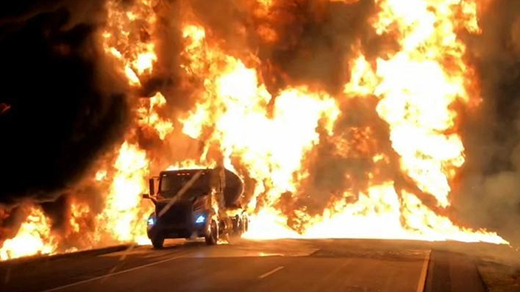
A certain highway

A dangerous goods warehouse
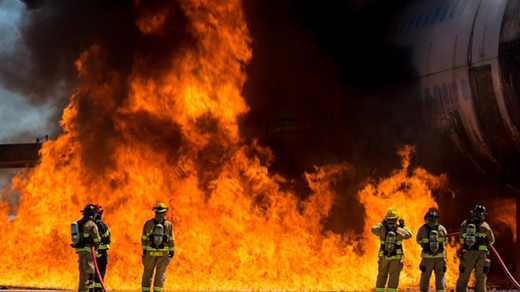
airport
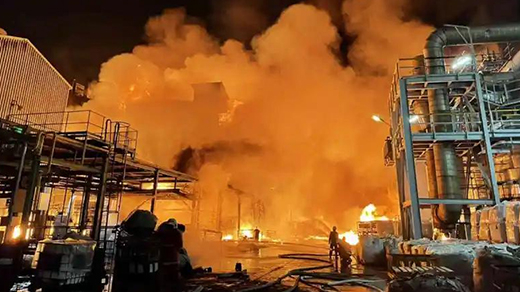
petrochemical industry